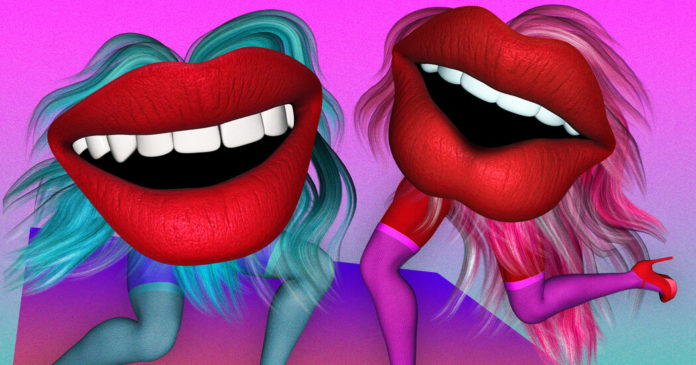
It is now perfectly acceptable for pop stars to lip-sync in live performances, as long as they supply a fantastical enough show in return. This spring, lip-syncing even ascended to the opera: In Opera Philadelphia’s short film “The Island We Made,” the “Drag Race” winner Sasha Velour appears as a spacey maternal spirit, channeling the singer Eliza Bagg’s voice through her glittery red lips. And this fall, you can take a Zoom lip-syncing course with the performance scholar M.B Boucai, integrating the psychological gesture technique of Michael Chekhov and the mime tradition of Jacques Lecoq.
Even as lip-syncing reaches new artistic heights, TikTok has democratized it, encouraging its billion global users to casually sing along. The app accommodates performance styles as disparate as Rae executing basic cheerleading moves and a girl mouthing the Counting Crows’ “Shrek 2” track “Accidentally in Love” over youthful images of the Unabomber. On a crowdsourced app, it makes sense for the central creative feature to have a low barrier to entry. Just as Instagram made everyone a hipster photographer with its vintage filters, TikTok turns its audience into experimental mash-up artists, with self-conscious nods to artifice baked into the experience.
Besides, as our experience grows increasingly mediated, we’ve come to appreciate the skills of the people who do the mediating. Much of TikTok’s charm derives from its lo-fi aesthetic, its janky green-screen effects and shaky hand-held shots. There is no longer some suspicious Hollywood power broker pulling the strings. (Or if there is, he has swooped in later, after the TikToker is already internet famous.) The app has taken all of the hallmarks of Hollywood manipulation — dubbing, but also airbrushing and C.G.I. — and put them in the user’s hands, where they have employed them in hypnotic, surprising, occasionally beautiful ways.
In the drag tradition, lip-syncing freed the body of the physical demands of singing, cracking open stunning new visual possibilities. Lip-syncing on TikTok is less about testing the limits of the body than exploring the boundaries of the phone. Some of the app’s most interesting content is made by young people broadcasting from under their parents’ roofs, and in a sense they are practicing their own kind of clandestine burlesque, playing with their identities amid nondescript backgrounds The tech may be new, but the performances are as pure as singing into a hairbrush.
Addison Rae is not a standout lip-syncer, but that is not the point of her. A drag queen lip-syncs with spectacular effort and razor-sharp precision, but Rae telegraphs the opposite, wearing the practice with a flirtatious lightness and evincing the middling technique of an amateur. Her following on the app (84.6 million) feels unjustified by her skill set, but her approachability is part of the appeal. Perhaps you could be her, if you were born with superior tooth enamel and a preternatural awareness of your most flattering angles. Which is not to say that the actual job of TikTok star is easy: When Rae failed to post for a week in 2020, internet headlines speculated that she was pregnant, or dead.
Rae’s earliest TikToks are staged in carpeted rooms featuring bare walls and inert ceiling fans, but as she rose in popularity, her backgrounds grew increasingly glamorous — Hollywood group house, infinity pool, Kardashian inner sanctum. The early frisson of her videos, which played off a girl next door unexpectedly surfing the cultural currents to stardom, has dimmed. Now that the self-reinforcing TikTok algorithm has ensured her hegemony on the app, she is swiftly invading more traditional entertainment spheres. You can find her on YouTube, where she sings the brief yet tedious pop single “Obsessed”; at Sephora, where she sells her branded makeup line; and now on Netflix, which has signed her to a multi-picture deal.








